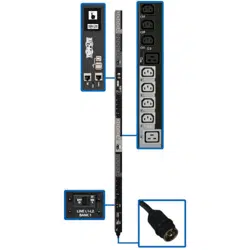Loading ...
Loading ...
Loading ...

101
5. Command Line Interface
The LX Platform device firmware supports features on the command line interface (CLI). Many of the functional controls available in the Web
console and Telnet interface are available on the command line interface. The CLI allows for the use of user-created scripts and easier integration
with third-party systems.
The CLI can be accessed on the LX Platform device via the USB Micro or RJ45 CONFIG port, via SSH on the default port 22, and via Telnet on
the default port 23. For security purposes, some features are only enabled on the USB Micro and SSH interfaces. Refer to section 4.3.2 for more
information on starting the CLI from the Telnet or SSH menu.
This section of the user manual will familiarize you with the way the CLI interprets your input and the meaning of the CLI output.
5.1 Syntax Conventions
The PowerAlert CLI uses its own standard syntax to interpret your input. The syntax defines standard conventions which are used to describe any
problems with the input. The next definitions are important for understanding the rest of this document and the CLI error messages.
1. Program - The ‘program’ refers to the software module that will interpret the user input and perform the work.
2. Program Name - The command keyword that is typed to invoke the program.
3. Directive - The entire phrase entered, including the program name and any arguments. The directive is broken down into several parts of
grammar, like a sentence.
4. Mode - The mode tells the program what to do with your arguments. A program can usually perform several different operations on the same
data. Program modes are: List, Add, Update, Delete, and Test. In some programs, the mode can be inferred without your specification; in
other programs, entering the mode will be required.
5. Mode Modifier - If the mode alone can’t describe your request, the program will have a mode modifier list. The mode modifier usually specifies
‘what’ to list and ‘where’ and ‘what’ to add, update, or delete.
6. Identifier - The update and delete modes support entering a numeric identifier to choose what data your new input will affect. The list mode
often allows an optional identifier to display more information about a single set of data.
7. Option - The option precedes your input parameter and specifies which value you are updating. An option will always begin with a dash
followed by a letter or double dash followed by a number or word.
8. Parameter - If an option requires a parameter, the parameter will follow the option or be appended to the option (for example, when choosing
SNMPv3: ‘--v3’).
The directive syntax breaks down along the grammatical boundaries shown below.
|----------------------------------------Directive----------------------------------------------|
|----------Preamble----------------------------|----------Predicate-----------------------------|
|-Program--|-Mode-|-Mode Modifier-|-Identifier-|----------Option List---------------------------|
|-Option-|-Parameter-|-Option-|-----Parameter----|
|-Subject--|-Verb-|-------Direct Object--------|--------------Indirect Object (List)------------|
addrbook -u email 4 --name santa --email [email protected]
All pieces of syntax are separated with single spaces. The interface does not support input containing spaces at this time, and the input cannot
include a single quote character.
Loading ...
Loading ...
Loading ...
